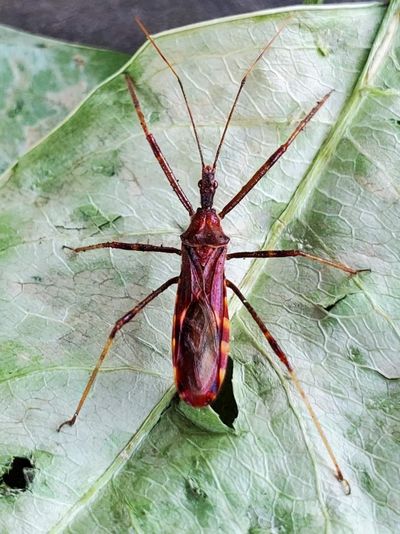Bugging the Northwest: Finally an assassin you want on your property

It’s hard to imagine an insect with a scarier sounding name than assassin bug. It conjures images of an arthropod that slips poison into drinks or lurks in shadows with a switchblade concealed under a wing.
But the aptly named assassin bug is named for how it stalks and attacks prey, not humans. The elongated insect with beady eyes proficiently uses a beak-like mouthpart to stab its victims and suck out their innards.
There are about 160 known species of assassin bugs in North America. The species recently found in a garden in Shoreline, Washington, is a four-spurred assassin bug, entomologist Michael Bush of the Washington State Department of Agriculture in Yakima said. The vibrant critter featured in the photograph was not easy to identify because it is “much more colorful than normal,” he said. The first part of the insect’s common name comes from the four spurs protruding from its pronotum (the plate-like covering over the thorax), he added.
Scientifically called Zelus tetracanthus, the four-spurred assassin bug is a stealthy predator with a big appetite that keeps pest numbers down in gardens, orchards and crop fields.
“This bug is truly an assassin bug that preys preferably on caterpillars such as cutworms, budworms and leafrollers,” Bush said.
They are considered a friend to gardeners, along with tree fruit, alfalfa and corn growers, he said.
With nearly 7,000 species of assassin bugs worldwide, they come in a variety of sizes and colors. One thing they share in common is a proboscis, a curved, dagger-like mouthpart that spears its prey and then injects toxins that liquefies its insides. Next, the proboscis acts like a fountain straw and sucks out the prey’s fluids.
Assassin bugs also use this sleek appendage to defend themselves. Adding to the insect’s bad-boy image is the fact that it produces two distinct types of venom – one to kill prey and the other to fend off predators, according to a 2018 paper published in the journal Nature Communications.
The four-spurred assassin bug will strike back if threatened, whether by a bird or human, Bush said.
“These tiny little assassins may inflict a painful bite to humans only in self-defense if handled. It’s best to let these bugs alone and avoid touching them,” he said.